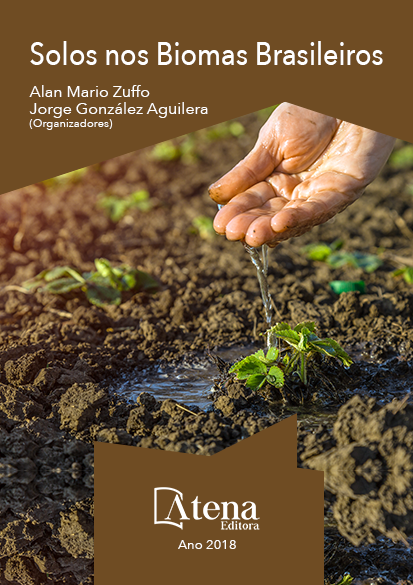
ARMAZENAGEM DE ÁGUA EM SOLO INFECTADO COM FUSÁRIO E CULTIVADO COM MARACUJAZEIRO, CULTIVAR BRS RUBI EM QUATRO COMBINAÇÕES COPA:ENXERTO
Diante da necessidade de avaliar
o comportamento físico-hídrico do solo e a
resposta fitotécnica do maracujá, o trabalho
objetivou monitorar a armazenagem de água
em um Latossolo Vermelho Amarelo, infectado
por fusário e cultivado com maracujazeiro,
cultivar BRS Rubi, enxertado em quatro portaenxertos (P. gibertii, P. alata, P. nítida e HFOP08), além do pé-franco do BRS Rubi. Para
tanto, o delineamento estatístico foi em blocos
aleatorizados, composto por cinco tratamentos
e três repetições, totalizando 45 tensiômetros.
A área experimental está localizada no
Instituto Federal Baiano, Campus Guanambi
(coordenadas geográficas: 14°1330 S; 42°4653”
W; altitude de 525 m; precipitação pluvial
média de 663,69 mm e temperatura média
de 26°C). O sistema de cultivo foi irrigado por
gotejamento. Como o sistema radicular efetivo
do maracujá encontra-se a uma profundidade
de 0,3 a 0,35 m, o volume de controle de solo
utilizado para o estudo da armazenagem da
água teve como limite superior a superfície do
solo e como limite inferior profundidade de 0,4
m. Para a determinação dos perfis de umidade
do solo ao longe da ciclo da cultura e posterior
armazenagem de água foram utilizados
tensiômetros. Para tanto, foram instalados
tensiômetros nas profundidades de 0,3; 0,4 e
0,5 m, sendo que o cálculo da armazenagem
de água foi feito pelo método do trapézio,
após transformação dos potenciais mátricos
em conteúdo de água no solo, por meio da
curva de retenção da água no solo. A maior
produtividade observa-se no tratamento HFOP
+ BRS Rubi atingindo 2.391,84 kg ha-1, obtendo
assim menores valores de água armazenada
no solo. O tratamento NÍTIDA + BRS Rubi afere
maior armazenagem de água nas camadas
0-0,5; 0-0,4; 0,3-0,5 m, respectivamente.
ARMAZENAGEM DE ÁGUA EM SOLO INFECTADO COM FUSÁRIO E CULTIVADO COM MARACUJAZEIRO, CULTIVAR BRS RUBI EM QUATRO COMBINAÇÕES COPA:ENXERTO
-
DOI: 10.22533/at.ed.0871814124
-
Palavras-chave: Tensiômetro; Gotejamento; Fusariose.
-
Keywords: Atena
-
Abstract:
The objective of this work was to monitor the storage of water in a
Red Yellow Latosol, infected by fusarium and cultivated with passion fruit, cultivar
BRS Rubi, grafted on four rootstocks (P. gibertii, P. alata, P. nítida and HFOP-08), in
addition to the BRS Rubi ungrafted. For that, the statistical design was in randomized
blocks, composed of five treatments and three replicates, totaling 45 tensiometers.
The experimental area is located at the Baiano Federal Institute, Guanambi Campus
(geographical coordinates: 14°13’30’’ S, 42°46’53’’ W, 525 m altitude, average rainfall of
663.69 mm and average temperature of 26 ° C). As the effective root system of passion
fruit is at a depth of 0.3 to 0.35 m, the soil control volume used for the study of water
dynamics was the surface area of the soil and, as a lower limit, a plane at a depth of 0.4
m. For the determination of the water content in the soil and subsequent water storage
were used tensiometers installed at depths of 0.3; 0.4 and 0.5 m. The calculation of
the water storage was done by the trapezoid method, after transformation of the matric
potentials in water content in the soil, by means of the water retention curve in the soil.
The highest productivity is observed in the HFOP-08 + BRS Rubi treatment, reaching
2,391.84 kg ha-1, thus obtaining lower values of water stored in the soil. The NÍTIDA +
BRS Rubi treatment has a higher water storage in the 0-0.5 layers; 0-0.4; 0.3-0.5 m,
respectively
-
Número de páginas: 15
- Marcelo Couto de Jesus


